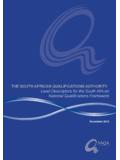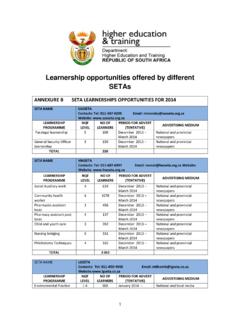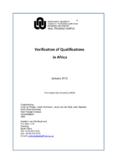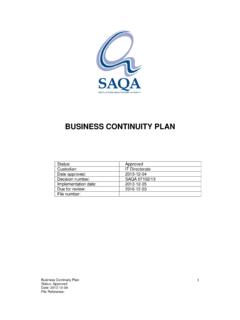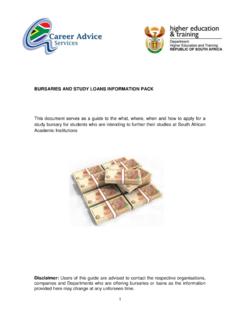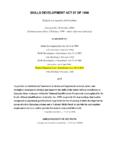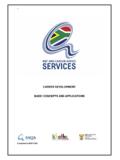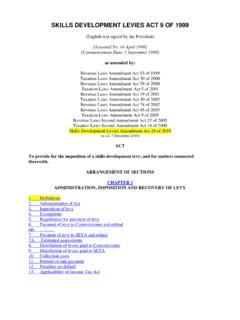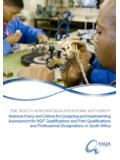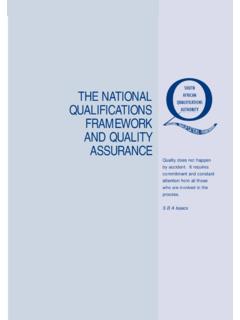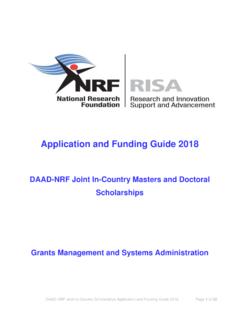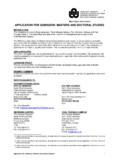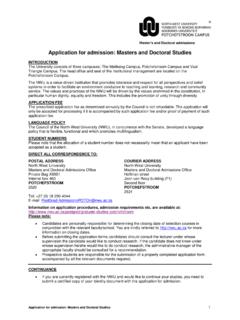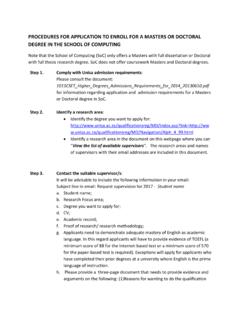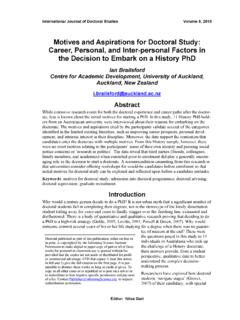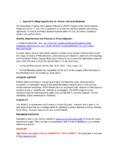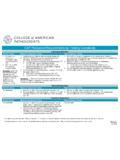Transcription of Statistics on Post-School Education and Training in …
1 Statistics onPost- school Education and Trainingin South Africa: 2011 Statistics on Post-School Education and Training in South Africa: 2011iiStatistics onPost- school Education and Trainingin South Africa: 2011 2013iiiiDepartment of Higher Education and Training123 Francis Baard Street PretoriaSouth AfricaPrivate Bag X174 Pretoria0001 Tel.: 0800 87 22 22 Department of Higher Education and TrainingThis publication may be used in part or as a whole, provided that the Department of Higher Education and Training is acknowledged as the source of the Department of Higher Education and Training does all it can to accurately consolidate and integrate national Education information, it cannot be held liable for incorrect data and for errors in conclusions, opinions and interpretations emanating from the information.
2 Furthermore, the Department of Higher Education and Training cannot be held liable for any costs, loss or damage that may arise as a result of any misuse, misunderstanding or misinterpretation of the statistical content of the publication. ISBN: 978-1-77018-707-8 This report is available on the Department of Higher Education and Training 's website: copies are obtainable from:Tel.: 012 312 5297 Fax: 012 312 6355 Email: layout and printing: Formeset Digital Tshwane (Pty) on Post-School Education and Training in South Africa: 2011iiiiiiFOREWORDIt gives me great pleasure to release Statistics on Post-School Education and Training in South Africa: 2011, the first such publication of the Department of Higher Education and Training . It follows on similar reports produced by the former Department of Education over the period 1997 to 2009.
3 These reports can be found on the website of the Department of Higher Education and Training : This publication details the size and shape of Post-School Education and Training in South Africa by reporting on, in the main, student enrolment, staffing levels, student passes and student graduates in Post-School Education and Training institutions as at 2011. It provides data pertaining to public higher Education institutions, public and private Further Education and Training Colleges, public and private Adult Education and Training Centres, Sector Education and Training Authorities, Artisans and the National Skills Fund, as at 2011. The Statistics reflected herein are used by the Department as well as Treasury to inform the allocation of budgetary resources.
4 They are therefore of vital importance. These Statistics also lay the foundation for the planning and reporting processes of government, as well as for the monitoring and evaluation of Post-School Education and Training . The publication provides basic statistical evidence which can be used together with research and analysis to inform policy and decision-making at the different levels of the system and is therefore crucial to the achievement of the goals of the Post-School addition to public and private Education and Training institutions, other government departments, research organisations, labour market analysts, the private sector in general and public entities are encouraged to use the information contained in this publication in their endeavors to improve the delivery of Education and Training in the country.
5 I wish to thank the Heads of the nine provincial Education departments, their Education Management Information System (EMIS) units, Further Education and Training College principals, Adult Basic Education and Training Centre managers, the Heads of Universities, the Sector Education and Training Authorities, the National Artisan Moderating Body and the National Skills Fund for providing the data to make this publication possible. I am indebted to you for undertaking the challenging task of establishing, managing and maintaining complex management information systems that have yielded the content of this publication. SIGNATURE Director-General: Department of Higher Education and TrainingPretoria, South AfricaForewordivivTABLE OF CONTENTS List of TablesList of FiguresList of Education AND Training INSTITUTIONS: AN OVERVIEW HIGHER Education INSTITUTIONS Introduction Enrolments Graduates Education AND Training (FET) Public Further Education and Training Overview by enrolment and staff per college enrolment by Full-time Further Education and Training Number of Private FET Colleges results of public and private FET Colleges 5.
6 ADULT Education AND Training (AET) CENTRES Introduction Overview by province Public and private centres Enrolment Staffing Examination Results Education AND Training AUTHORITIES (SETAs) Workers enrolled Workers certificated Unemployed enrolled Unemployed certificated7. ARTISANS Introduction Artisans assessed at Artisans certificated by SETAs SKILLS FUND (NSF) Introduction Number of projects per province Targeted number of beneficiaries NOTES Introduction Scope Methodology Response rate 10. GLOSSARY 11. CONTACT DETAILS vvvi122239141515151516182021222222232326 26 2627272828303030313233343434353636363637 373737373841 Table of contentsvvLIST OF TABLES LIST OF FIGURES Table 1: Number of institutions and student enrolment: 2011 Table 2: Overview of enrolment in public higher Education institutions: 2011 Table 3: Headcount enrolments in public higher Education institutions, by major field of study and qualification type: 2011 Table 4: Headcount enrolments in public higher Education institutions by attendance mode, population group and gender: 2011 Table 5: Full-Time equivalent student enrolments by attendance mode in public higher Education institutions: 2011 Table 6.
7 Number of graduates of public higher Education institutions, by major field of study and qualification type: 2011 Table 7: Summaries of graduation rates in public higher Education institutions: 2011 Table 8: Undergraduate success rates of contact and distance mode students in public higher Education institutions, by population group: 2011 Table 9: Overview of permanent staff in public higher Education institutions: 2011 Table 10: Overview of the public FET College sector, by province: 2011 Table 11: Number of staff and students per college: 2011 Table 12: Number of students per college and per programme: 2011 Table 13: Number of full-time equivalent (FTE) enrolments per college: 2011 Table 14: Number of staff per college and per category: 2011 Table 15: Headcount enrolment per programme and per gender in 2011 Table 16: Number of students per occupational programme and per level in 2011 Table 17: Number of staff per category and gender: 2011 Table 18: Number of NC(V) Level 4 students registered, wrote and passed, per course and gender in 2011 Table 19: Number of NSC students registered, wrote and passed, per course and gender in 2011 Table 20: Number of Report 191 N3 students registered, wrote and passed, per course and gender in 2011 Table 21: Number of Report 191 N6 students registered, wrote and passed, per course and gender in 2011 Table 22: Number of learners, educators and institutions in AET Centres by province: 2011 Table 23: Number of centres per province and per type in 2011 Table 24.
8 Number of learners per province and per level: 2011 Table 25: Number of staff per province and per category and gender in 2011 Table 26: Number of learners entered, wrote and passed, per province: 2011 Table 27: Number of learners entered, wrote and passed, per province and gender in 2011 Table 28: Number of workers enrolled in SETA learning programmes, per category for the period 2011/2012 Table 29: Number of workers certificated in SETA learning programmes, per category for the period 2011/2012 Table 30: Number of unemployed persons enrolled in SETA learning programmes, per category for the period 2011/2012 Table 31: Number of unemployed persons certificated in SETA learning programmes, per category for the period 2011/2012 Table 32: Number of Artisans assessed at INDLELA per section for the period 2011/2012 Table 33: Number of artisans certificated by SETAs, per economic sector for the period 2011/2012 Table 34: Number of projects per province for 2011 Table 35: Targeted number of beneficiaries for 2011 Figure 1: Percentage distribution of headcount enrolments in public higher Education institutions, by major field of study: 2011 Figure 2: Percentage distribution of headcount enrolments in public higher Education institutions, by qualification type: 2011 Figure 3: Percentage distribution of headcount enrolments in public higher Education institutions, by attendance mode and gender: 2011 Figure 4.
9 Full-time equivalent student enrolments in public higher Education institutions, by attendance mode: 2011 Figure 5: Percentage distribution of average undergraduate success rates in public higher Education institutions, by contact Education programmes and population group: 2011245781011121416171920212222232324242 52627272828293031323334353636668913 List of Tables and FiguresviviABBREVIATIONSAETA dult Education and TrainingAGRISETAA griculture Sector Education Training and AuthorityBANKSETAB anking Sector Education and Training AuthorityCATHSSETAC ulture Arts, Tourism, Hospitality and Sport Sector Education Training AuthorityCETAC onstruction Education and Training AuthorityCHIETAC hemical Industries Education and Training AuthorityDBED epartment of Basic EducationDHETD epartment of Higher Education and TrainingEMISE ducation Management Information SystemETQAE ducation and Training Quality AssuranceETDPSETAE ducation and Training Development Practices Sector Education Training AuthorityEWSETAE nergy and Water Sector Education and Training Authority Sector Education Training AuthorityFASSET Finance, Accounting.
10 Management Consulting and other Financial Services Sector Education Training AuthorityFETF urther Education and TrainingFETMISF urther Education and Training Management Information System FOODBEVFood and Beverage Manufacturing Industry Sector Education Training AuthorityFP&MSETAF ibre Processing and Manufacturing Sector Education Training AuthorityFTEFull-Time EquivalentGETG eneral Education and TrainingHEDCOMH eads of Education Departments CommitteeHEIH igher Education InstitutionHEMISH igher Education Management Information SystemHWSETAH ealth and Welfare Sector Educational Training AuthorityINDLELAI nstitute for the National Development of Learnerships, Employment Skills and Labour AssessmentsINSETAI nsurance Sector Education and Training Authority LGSETAL ocal Government Sector Education Training AuthorityMERSETAM anufacturing, Engineering and Related Services Sector Education Training AuthorityMICTSETA Media Information and Communication Technologies Sector Education Training AuthorityMQAM ining Qualification Authority NAMBN ational Artisan Moderation BodyNC(V)National Curriculum (Vocational)
